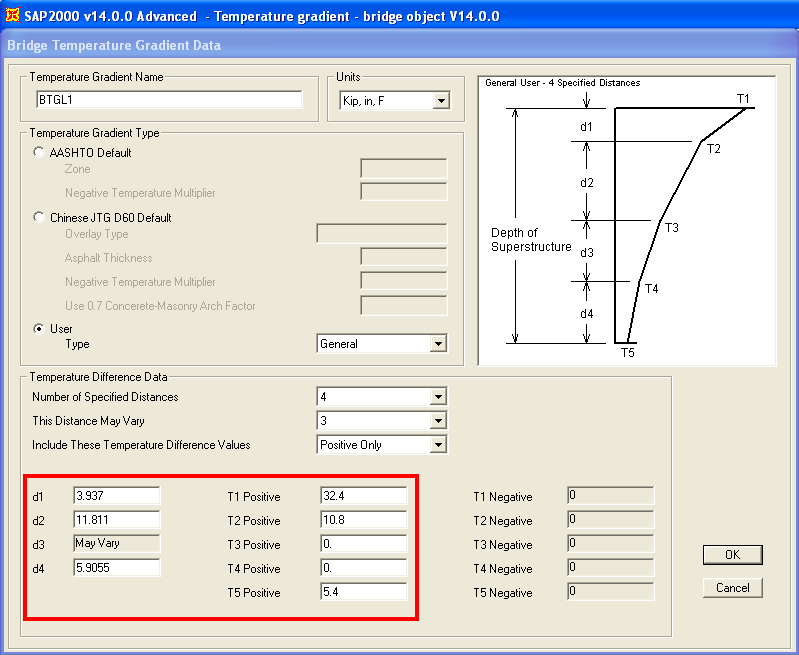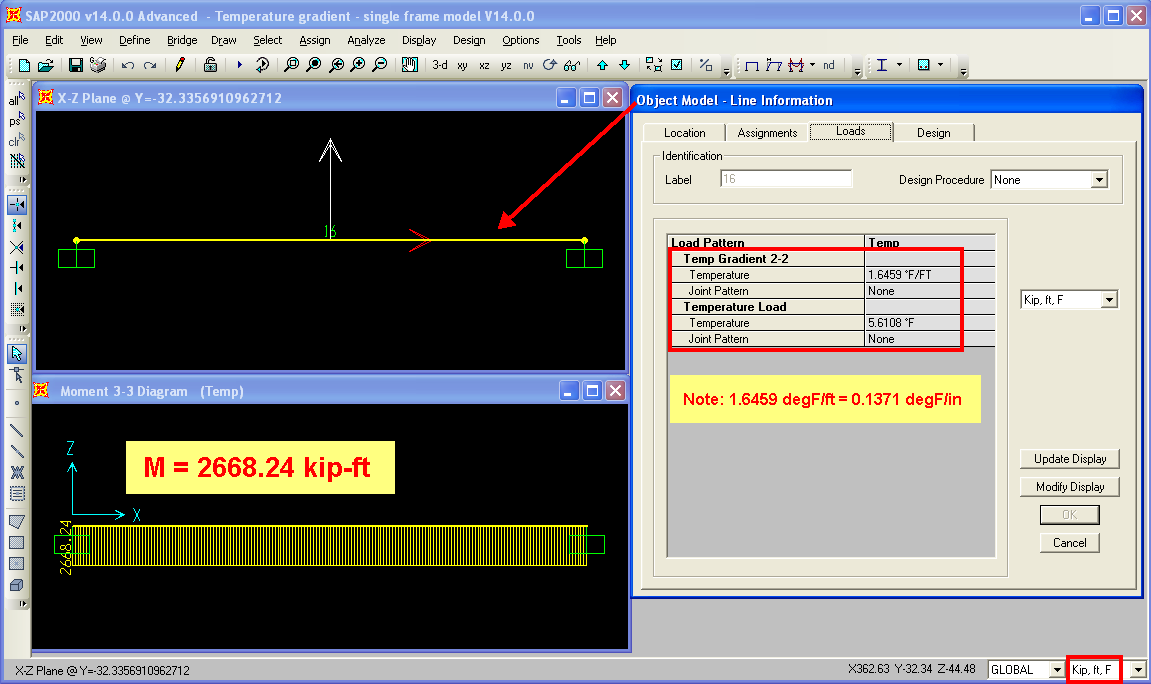{{
| Live Template | |
|---|---|
|
|
name = Temperature gradient loading for bridge objects |
description = Illustrate the program calculates and applies temperature gradient loading to bridge objects |
keyword = bridge modeler; bridge; temperature gradient; temperature |
program = SAP2000 |
version = V14.0.0 |
status = done |
id = ok/bridge - temperature gradient loading}} |
| On this page |
|---|
This test problem explains and demonstrates the application of The purpose of this tutorial is to explain how SAP2000 applies temperature gradient to bridge objects. SAP2000 is applying the specified To summarize the process, temperature gradient is specified and applied to the transformed section, calculating the generated axial force (P) and moment (M3) are calculated, then applying an equivalent temperature distribution (constant + linear temperature distribution ) is applied over the depth. The emphasis here is on getting
This process enables the correct calculation of overall section cross-sectional force and moment on the cross section. If we were to apply the actual temperatures at the nodes as gotten from the specified temperature distribution, the . Nodal application of actual temperatures induced by the temperature distribution specified would yield incorrect net force and moment would be wrong unless without the cross section was being finely discretized.
Procedure
For the original gradient, you can calculate the stress distribution simply as E \alpha T. Integrate this analytically The stress distribution of a temperature gradient is calculated as E α T. Users may analytically solve for axial force (P) by integrating this expression over the section, accounting for the webs and flanges to get the P. Integrate web and flange areas. To solve for M3, integrate the moment of the stresses about the neutral axis to get M3.Now assume a linear temperature . CSI Software derives temperature-gradient response by following these formulations. First, the software assumes a linear gradient with two unknowns: the value at the neutral axis, and the gradient. Integrate this over the sections, equate P and M3 to the previous results, and solve for the two unknowns. This is be equal to the values used by SAP2000, including neutral-axis value and gradient slope. Integration procedures yield a set of polynomial expression for P and M3. Simultaneous solution then yields exact expressions for axial force and moment.
Examples
The general approach described above is illustrated using the two below examples. Refer to the following two examples demonstrate temperature-gradient application. Screenshots and attached hand calculations and the screenshots included for each example for additional detailsillustrate the procedure.
Example 1
...
: Bridge-modeler model
Please refer to note that the attached hand calculations for attached provide additional details.
The bridge modeler was used to create a single A single-span concrete-box bridge, fixed at both abutments, is created using the bridge modeler. The linked bridge object was is updated as a solid model. Temperature Loading from temperature gradient loading is defined as shown in the figure belowFigure 1:
The program calculates solid temperature loads based on equivalent constant plus linear temperature gradient:
Figure 1 - Temperature-gradient loading
As mentioned earlier, an equivalent constant + linear temperature gradient generates the temperature load for a solid model. This procedure correlates precisely with the attached hand calculations , as shown in Figure 2:
Figure 2 - Temperature-gradient loading on solid elements
For bridge response, loading from the temperature gradient induces The temperature gradient loading causes a moment of 2568 kip-ft, which compares closely to correlates with the hand calculated moment of 2669 kip-ft. Software output is shown in Figure 3:
Figure 3 - Moment induced by temperature gradient
Example 2
...
: Single frame-element model
Please note that the hand calculations attached provide Please refer to the attached hand calculations for additional details.
For this example 2, a single, beam frame element is fixed at both ends was and manually loaded by with the manually calculated constant plus + linear temperature gradient loading. The Element cross - section of the frame element was is defined to match those properties of the entire bridge deck section for from example 1. The temperature-gradient loading creates a moment of 2668 kip-ft, which compares closely nearly identical to the hand-calculated moment of 2669 kip-ft. Software output is shown in Figure 4:
See Also
Attachments
Figure 4 - Temperature-gradient on the frame-element model
Attachments
File | filename = Temperature gradient for bridge objects hand calculations.pdf | title = Hand caculations(PDF file, 2.07MB)- File | filename = Temperature gradient for bridge objects SAP2000 V14.0.0 models .zip | title = SAP2000 V14.0.0 models - one model with bridge object and other model with single frame element (Zipped SDB files, 0.5MB(zipped .SDB files) – Example 1: Bridge-modeler model, Example 2: Single frame-element model
- Hand calculations (PDF)



